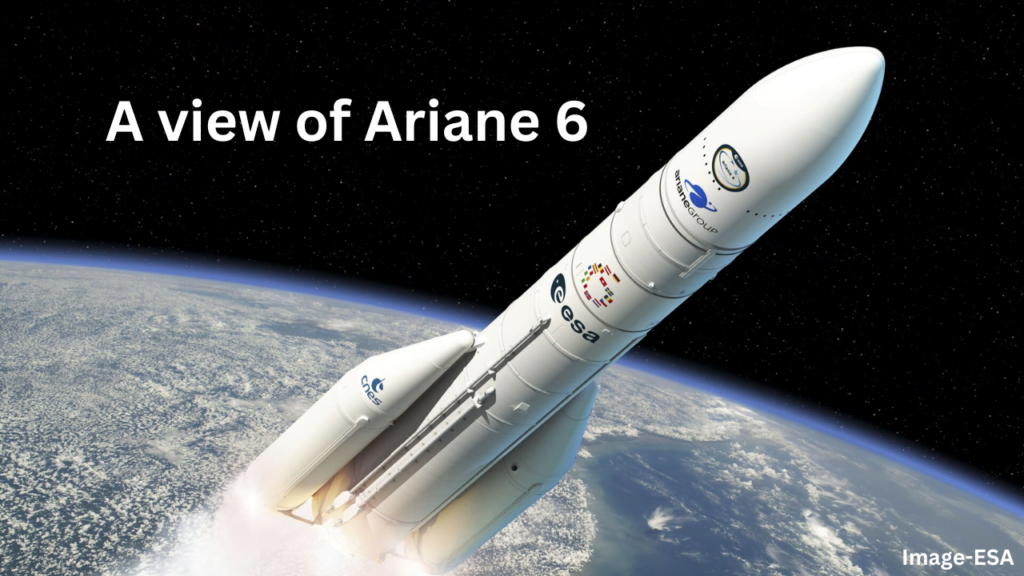Europe is about to witness a historic event as the Ariane 6 launch rocket gets ready for its first flight on Tuesday.
On July 9, between 2:00 and 6:00 p.m. Eastern (1800 and 2200 UTC), the Ariane 6 is scheduled to lift off from the Kourou launch pad in French Guiana as per the press release by the European Space Agency (ESA). The launch is being broadcast live on ESAWebTV by the ESA.

The European Space Agency’s (ESA) flagship rocket, the Ariane 6, represents a significant development in Europe’s space launch capability. Ariane 6, the very successful Ariane 5’s replacement, is designed to be more flexible, economical, and adaptive to the space industry’s ever-changing needs.
Ariane 6’s Development, Economic Impact, Challenges and Prospects
Ariane 6’s development was started in response to Europe’s desire to continue having independent access to space as well as growing competitive challenges in the global launch industry.
Europe has to keep up with innovation to remain competitive, especially with companies like SpaceX redefining the market with reusable rockets and much cheaper launch costs. The goal was to provide additional mission flexibility at a launch cost savings of about 40–50% over Ariane 5.
ArianeGroup, a joint venture between Airbus and Safran, developed the rocket under the direction of ESA and with substantial funding from European member states. The primary goals were to ensure reliability, lower launch costs, and increase launch frequency, thereby providing more flexible services for a wide range of payloads.

Design and Technical Specifications
It has two primary configurations;
Ariane 62, designed for medium-lift missions, has two strap-on rockets and can deliver up to 10.35 tons to low Earth orbit (LEO) and 4.5 tons to geostationary transfer orbit (GTO).
Ariane 64, designed for heavy-lift missions, has four strap-on rockets and can deliver up to 20 tons to low-Earth orbit (LEO) and 11.5 tons to geostationary transfer orbit (GTO).
The architecture of the rocket prioritizes efficiency and adaptability. The Vulcain 2.1 engine, which replaces the Vulcain 2 engine of the Ariane 5, powers the core stage by burning liquid hydrogen and liquid oxygen (LH2/LOX). The Vinci engine, which powers the upper stage, is built for numerous restarts, increasing mission flexibility by enabling the deployment of payloads into several orbits in a single launch.
Ariane 6’s modular design, which allows the rocket to be modified with varying quantities of solid rocket boosters (SRBs) to meet the unique requirements of each mission, is one of its main developments. Being modular is a big step in cutting expenses and speeding up the time between launches.

Economic and Strategic Impact
Ariane 6 is key to Europe’s goal for maintaining a competitive edge in the global launch industry. It hopes to attract commercial satellite operators who are increasingly looking for more cost-effective options by lowering launch costs and enhancing dependability. Furthermore, it secures Europe’s continued autonomous access to space, which is critical to the region’s strategic autonomy.
The rocket is anticipated to carry a wide range of payloads, including commercial satellites, scientific missions, and maybe components of future lunar and Mars missions. Its versatility makes it appropriate for a wide range of missions, from small satellite constellation deployment to interplanetary probe launches.
Challenges and Future Prospects
Despite its promising potential, Ariane 6 has encountered several hurdles. Due to development delays and expense overruns, the first flight will now take place in 2024, rather than 2020. These delays have been linked to the project’s complexity, the incorporation of new technology, and the COVID-19 epidemic, which disrupted logistics and halted production.
Looking ahead, Ariane 6’s performance will be critical for Europe’s space goals. Its ability to deliver on its promises of cost-effectiveness and dependability will decide its competitiveness versus other launch providers. Furthermore, the rocket’s performance and adaptability will have an impact on future European space missions, as well as prospective international cooperation on projects like lunar exploration and Mars missions.
Ariane 6 has already booked for 30 launches, 18 of which are for Amazon’s Kuiper constellation.
There is a sense of risk, with ambitions to increase its missions to 9 per year as soon as feasible, depending upon a successful flight.






